

Learning Objectives
- Learn the basic properties of light and how light is perceived as color
- Learn the basics of color theory
- Learn the basic molecular structure of a reactive dye molecule
- Learn how an alkali catalyst works to help form a covalent bond between the dye & fiber
- Use fiber reactive dyes to conduct a color mixing experiment & chemical reaction on a t-shirt with tie-dye
- Dharma Tie-Dye Big or Little Group Kit
- 100% Cotton Clothing / Fabric to dye
- Markers
- Household items (zip lock bags, etc)
- CMY Color Wheel
Words to Know
- wavelength
- electromagnetic
- spectrum
- additive color
- subtractive
- hydrogen bond
- hydroxyl group
- cellulose
- color
- hue
- saturation
- value
- alkali
- catalyst
- chromophore
- covalent bond
What is Color and What does it have to do with light?
Color is an effect produced by the eye and its nerves by light waves of different wavelength or frequency. Light transmitted from an object to the eye stimulates the different color cones of the retina, making possible perception of various colors in the object.
Since the colors that compose sunlight or white light have different wavelengths, the speed at which they travel through a medium such as glass differs; red light, which has the longest wavelength, travels faster through glass than blue light, which has a shorter wavelength.
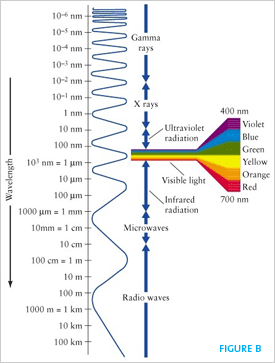
When white light passes through a glass prism, it is separated into a band of colors called a spectrum. The colors of the visible spectrum are usually called red, orange, yellow, green, blue, indigo, and violet. The phrase ROY-G-BIV is an easy way to remember this. This same effect happens when light goes through water droplets or rain causing us to see a rainbow.
Our eyes are sensitive to light which lies in a very small region of the electromagnetic spectrum labeled "visible light." This “visible light" corresponds to a wavelength range of 400 - 700 nanometers (nm) and a color range of violet through red. The human eye is not capable of “seeing" radiation with wavelengths outside the visible spectrum (see figure B).
The Color of Objects
Color is a property of light that depends on wavelength. When light falls on an object, some of it is absorbed and some is reflected. The apparent color of an opaque object depends on the wavelength of the light that it reflects; e.g., a red object observed in daylight appears red because it reflects only the waves producing red light. The color of a transparent object is determined by the wavelength of the light transmitted by it. An opaque object that reflects all wavelengths appears white; one that absorbs all wavelengths appears black. Black and white are not generally considered true colors; black is said to result from the absence of color, and white from the presence of all colors mixed together.
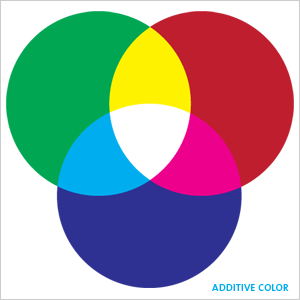
Additive Color
Colors whose beams of light in various combinations can produce any of the color sensations are called primary, or spectral, colors. The process of combining these colors is said to be additive: the sensations produced by different wavelengths of light are added together. The additive primaries of light are are red, green, and blue-violet. White can be produced by combining all three primary colors. Any two colors whose light together produces white are called complementary colors, e.g., yellow and blue-violet, or red and blue-green.
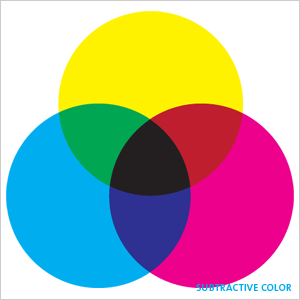
Subtractive Color
When pigments or dyes are mixed, the resulting sensations differ from those of the transmitted primary colors. The process in this case is “subtractive," since the pigments subtract or absorb some of the wavelengths of light. With transparent dyes, like our Fiber Reactive Dyes that we use for Tie-Dye, Cyan (blue-green), Magenta (red-violet), and Yellow and are called subtractive primaries, or primary colors. This is called the CMY system, and you use a CMY color wheel. (With more opaque pigmented products, like our fabric paints, use traditional Red, Yellow and Blue as primaries and use a Red, Yellow, Blue color wheel.) A mixture of cyan and yellow pigments yields green, the only color not absorbed by one pigment or the other. A mixture of the three primary pigments produces black. These subtractive primary colors are the ones we use when dyeing, and the Fiber Reactive Dye equivalents are Turquoise, Fuchsia, and Lemon Yellow.
Properties of Color
The scientific description of color, or colorimetry, includes all of the relevant properties of a color subjectively and objectively. The subjective description includes the hue, saturation, and lightness or brightness of a color.
HUE refers to what is commonly called color, i.e., red, green, blue-green, orange, etc.

SATURATION refers to the richness of a hue as compared to a gray of the same brightness; this is also known as chroma.

VALUE measures the brightness of an opaque object on a scale from dim to bright or from black to white.

Primary Colors are the colors that mix together to make all the Secondary Colors, magenta, cyan & yellow.

Secondary Colors are the colors you get when you mix Primary Colors: orange, green & purple.

Tertiary Colors are the in-between colors like red-orange or yellow-green They're made by mixing one primary color and one secondary color together. There are endless combinations of tertiary colors, depending on how they"re mixed.

Complementary Colors: magenta and green, cyan and orange, purple and yellow. These are the colors directly across from each other on the color wheel. They're called “complementary" because, when used together, they become extremely vibrant and have a lot of contrast. Complementary colors are useful when you want to make something stand out.

Analogous Colors: red and orange, blue and green, etc. These are colors right next to each other on the color wheel. They usually match extremely well, but they have little contrast. They're good for very serene-feeling designs and artwork where you want viewers to feel comfortable.

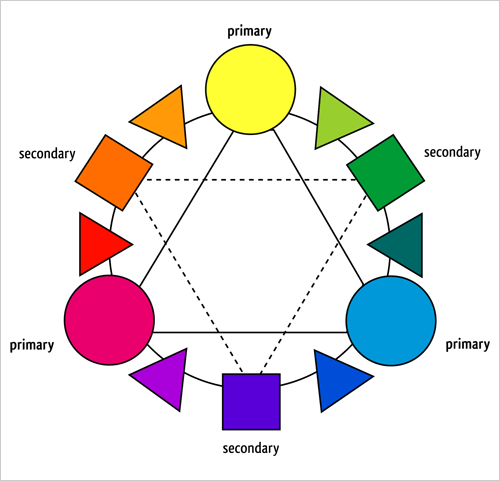
Color Quiz
Please answer the following questions.
1. What does saturation mean?
2. What 3 colors make white?
3. What are the 3 secondary colors (draw a diagram if you need to)?
4. What is added together to create additive color?
5. Colors can be associated with mood and feelings. Name at least one color that provokes a feeling, and which feeling?
Fiber Reactive Dyes are so called because they under go a chemical reaction with the fiber during which they form a covalent bond to the fiber. The dyes have a reactive molecular group on them that reacts with the hydroxyl (-OH) groups on of cellulose fibers, so they can be used on cotton, hemp, linen, rayon and other plant based fibers.
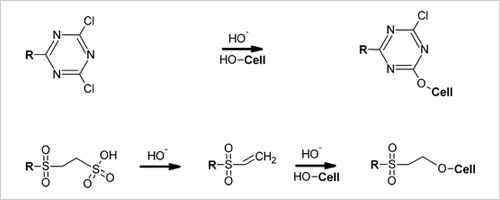
To speed the reaction and help the dye fix to the fiber, an alkali is used as a catalyst. For Fiber Reactive Procion Dyes the alkali used is Soda Ash. The alkali strips hydrogen atoms off of the cellulose molecules so that the dye can easily form the covalent bond with the oxygen in the hydroxyl (-OH) groups. There is one draw back to this reaction, the hydroxyl groups are very much like water molecules which are H20 and the dye will start to form hydrogen bonds with the water if it is left to sit for too long. Once you mix up the dye it is best to use it within 24 hours.
While the reactive group is what makes it possible for the dye molecule to fix on to the fabric the main part of the dye that actually makes it appear a certain color is call a chromophore. When light hits a chromophore its molecular structure determines how is absorbs and reflects light. The reflected light from the chromophore is what we see as color. Different dyes have different chromophores and when we mix the dyes on the fabric, the different wavelengths of light that each reflect back mix in our eyes. That is how we create different colors by mixing the dyes.
There are many ways to apply Fiber Reactive Dyes, making them very versatile for all kinds of projects.
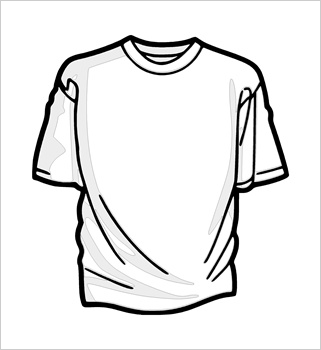
Now that you know about color theory and how subtractive color mixing work, you are ready to start planning the colors for your tie-dye project. The Primary Dharma Fiber Reactive Dye colors that correspond to the CMY primaries are as follows:
- Magenta #13: Fuchsia Red
- Cyan #25: Turquoise
- Yellow #1: Lemon Yellow
You mix colors on your shirt by applying the dye to the same area of shirt. Keep in mind that when you add all three colors to one area you will get a shade of brown. Unless you really love browns, it is best to try and only have two primary colors touching in most areas of the shirt.
You can use the t-shirt to the left to help you plan where you want to put color on your shirt, keeping in mind it is going to be all folded and tied up. By drawing circles or lines you can help plan how and where you are going to tie and fold your shirt, this will give you a better idea of what it will be like when you are done.












